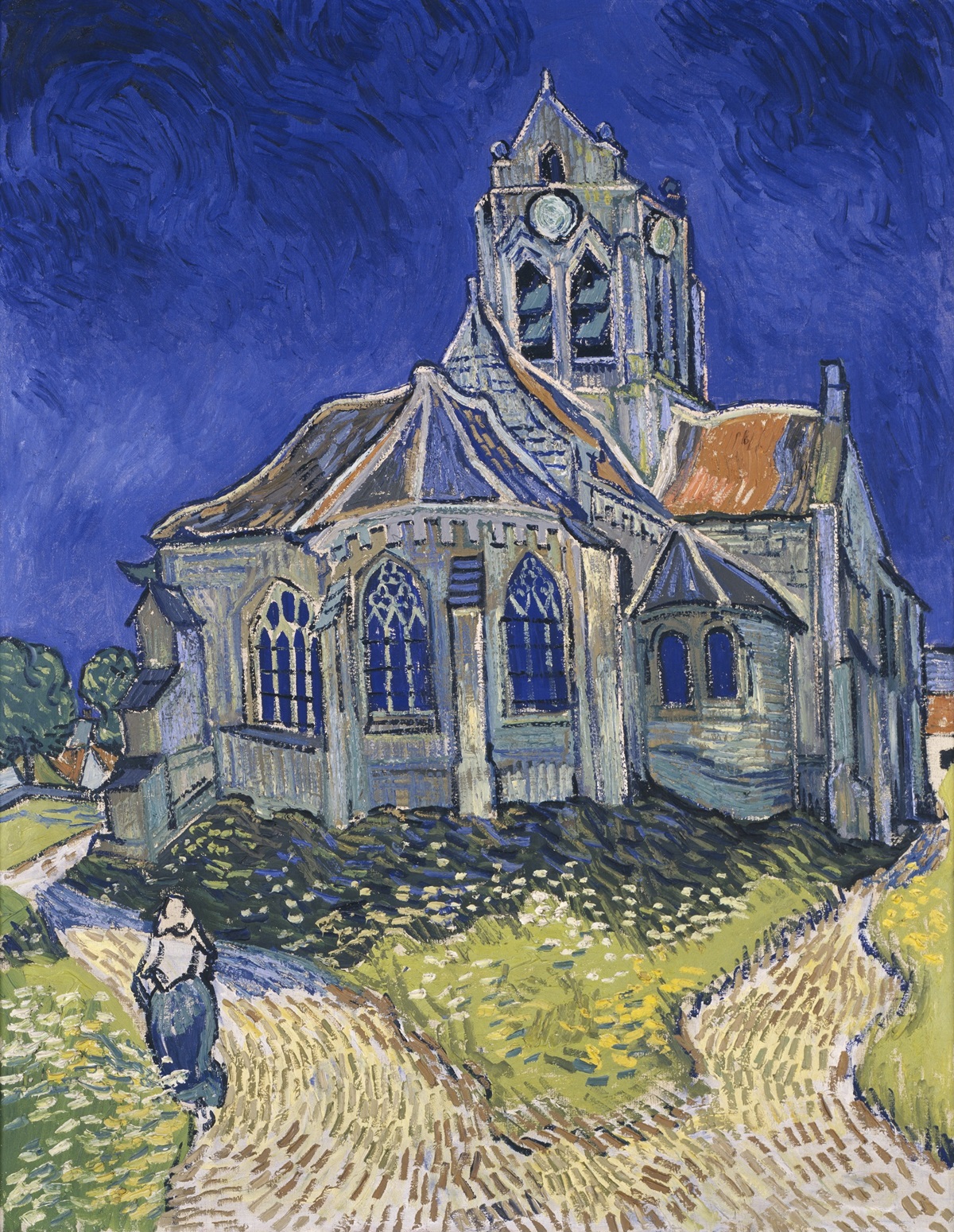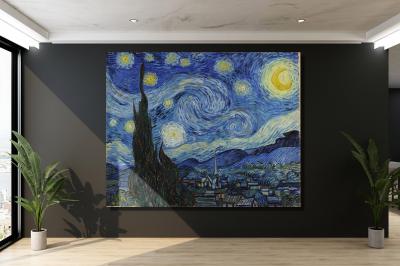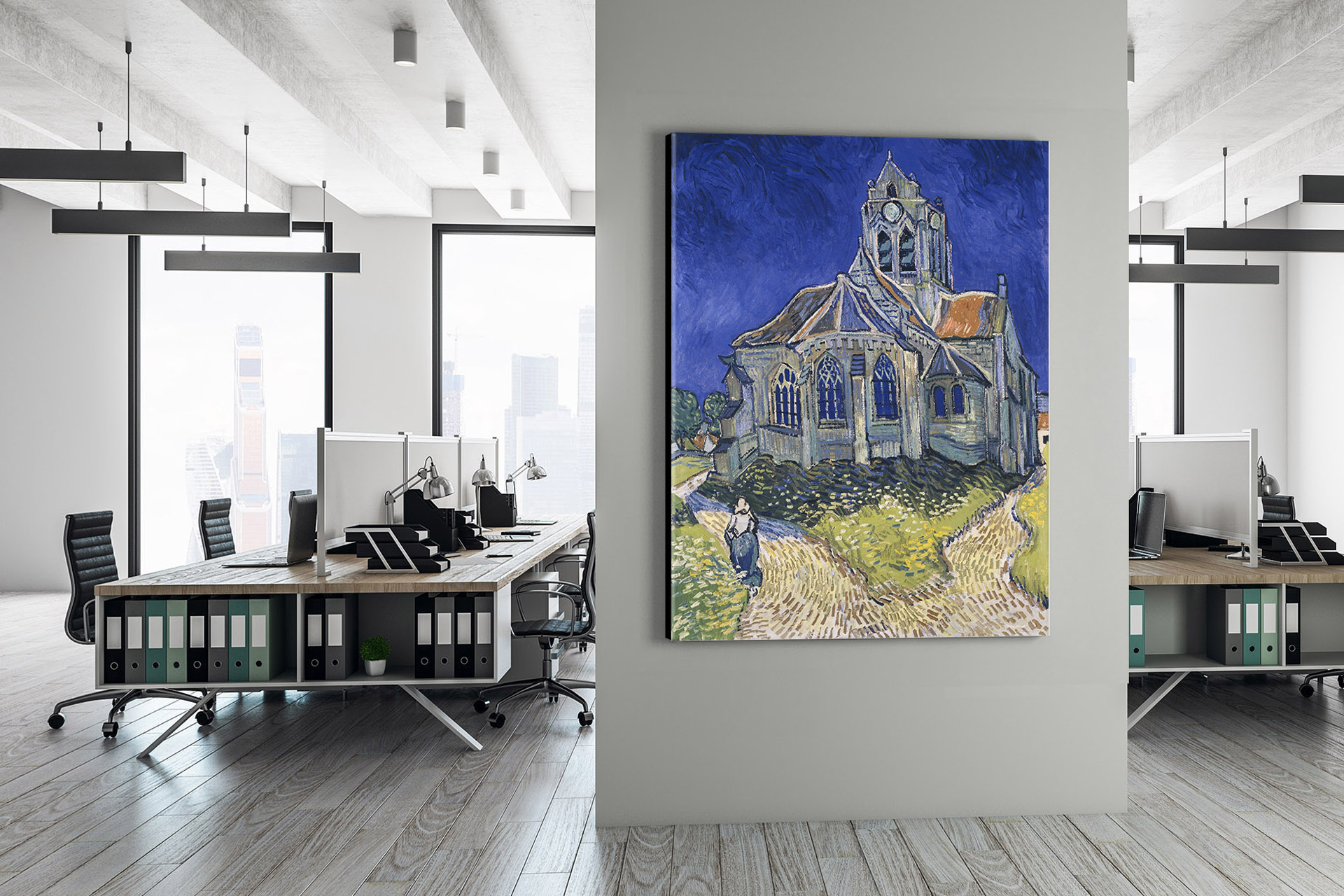The Church at Aurers
By Vincent van Gogh, 1890
Vincent van Gogh’s “The Church at Auvers”: An Immersive Exploration of Artistry Amidst Turmoil
In the annals of art history, few names command the same reverence and fascination as Vincent van Gogh. Among his many masterpieces, “The Church at Auvers” stands as a confirmation to his genius and the tumultuous emotions that fueled his creative fire. This article embarks on an in-depth journey into this iconic painting, unveiling its profound significance while diving deeper into the enigmatic life and mind of the tormented artist. Moreover, we will explore the technical challenges van Gogh faced, the importance of the painting’s location in Auvers-sur-Oise, and delve into the intricate narrative of the painter himself.
Auvers-sur-Oise: A Sanctuary of Inspiration
In May 1890, seeking refuge from the tumultuous urban life and the relentless grip of mental illness, Vincent van Gogh found solace in the idyllic French village of Auvers-sur-Oise. This picturesque village, adorned with charming cottages and framed by serene landscapes, was the ideal canvas for van Gogh’s creative fervor. Under the care of Dr. Paul Gachet, a compassionate physician and art enthusiast, Vincent embarked on a journey that would ultimately culminate in the creation of “The Church at Auvers.”
“The Church at Aurers” Large Canvas Prints from WhiteClouds
The Church: Symbolism Beyond Aesthetic
Van Gogh’s portrayal of the church in Auvers-sur-Oise is more than just a picturesque subject; it is an embodiment of his inner turmoil and a symbol of hope and redemption. The Romanesque church, with its imposing presence and weathered stone walls, dominates the canvas with stark, angular lines. It stands in stark contrast to the vibrant, swirling skies above, a juxtaposition that mirrors the relentless conflict within the artist’s own mind.
Technical Challenges: Mastery Amidst Struggle
“The Church at Auvers” not only reflects van Gogh’s emotional turmoil but also showcases his technical prowess. The artist faced numerous challenges while painting this masterpiece, from capturing the play of light and shadow on the church’s facade to rendering the intricate details of the surrounding landscape. Van Gogh’s innovative use of color, thick impasto brushwork, and textured application of paint set him apart as a master of the craft. The swirling patterns of blues and yellows in the sky are a direct reflection of his inner tumult, while the thick, expressive brushstrokes in the landscape and the church’s stonework reveal his relentless pursuit of perfection.
Location Matters: Auvers-sur-Oise’s Impact
The choice of location played a pivotal role in the creation of “The Church at Auvers.” Auvers-sur-Oise’s tranquil charm and the serene countryside served as a profound source of inspiration for van Gogh. The unique interplay of natural elements, village life, and the iconic church allowed him to imbue the painting with a sense of timelessness and authenticity. The quaint setting of Auvers-sur-Oise became an integral part of the artwork, further underscoring the deep connection between the artist and his surroundings.
Van Gogh: The Tormented Genius
Vincent van Gogh’s life was as compelling as his art. Born in 1853 in Zundert, Netherlands, he struggled with mental health issues throughout his life. His emotional intensity and desire to find meaning in existence found their outlet in painting. Despite the adversity he faced, van Gogh produced over 2,000 artworks during his short, prolific career.
The artist’s work was characterized by bold colors, expressive brushwork, and a profound exploration of human emotions. However, his mental health deteriorated, leading to episodes of depression and manic creativity. Van Gogh famously cut off his ear during a fit of madness and spent time in various asylums.
Tragically, Vincent van Gogh’s life was cut short when he died by suicide at the age of 37 in 1890. It was only in the years following his death that his genius was truly recognized, and his impact on the art world became immeasurable. Today, his paintings, including “The Church at Auvers,” continue to captivate and inspire art enthusiasts worldwide, a testament to the enduring power of his artistry.
 The Church at Auvers by Vincent van Gogh
The Church at Auvers by Vincent van GoghConclusion
Vincent van Gogh’s “The Church at Auvers” is a masterpiece that transcends the canvas, offering an immersive exploration of the artist’s intricate psyche and tumultuous life. It stands as a testament to his uncanny ability to channel inner demons into art that continues to captivate viewers today. The painting’s interplay of serenity and turmoil, its vivid colors, its technical brilliance, and its deep spiritual undertones make it a compelling representation of van Gogh’s artistic genius. Additionally, the significance of Auvers-sur-Oise in shaping the masterpiece adds another layer of complexity to its narrative. As we gaze upon this iconic work, we are reminded of the enduring power of art to convey the depths of human emotion and the lasting legacy of a tormented yet extraordinary artist. “The Church at Auvers” remains an indelible mark on the canvas of art history, forever echoing the profound complexity of Vincent van Gogh’s soul, a soul that burned brightly and fiercely in the pursuit of artistic truth.
Frequently Asked Questions About “The Church at Auvers”
What is the significance of “The Church at Auvers” in Vincent van Gogh’s body of work? “The Church at Auvers” holds significance as one of van Gogh’s last masterpieces, created during his tumultuous final months. It reflects his emotional state and artistic genius, making it a poignant representation of his life’s work.
Where is “The Church at Auvers” currently housed or displayed? “The Church at Auvers” is part of the collection at the Musée d’Orsay in Paris, France, where it is often displayed as a highlight of their Impressionist and Post-Impressionist collection.
What was the inspiration behind van Gogh’s choice to paint the church in Auvers-sur-Oise? Van Gogh was inspired by the rustic charm of Auvers-sur-Oise and found the church to be an iconic symbol of the village. He saw it as a source of spiritual and artistic inspiration.
Can you explain the symbolism of the contrasting elements in the painting, such as the dark church and the swirling sky? The dark, imposing church represents inner turmoil, while the vibrant sky symbolizes hope and struggle. This stark contrast reflects van Gogh’s emotional state.
What were the technical challenges van Gogh faced while creating this artwork? Van Gogh grappled with capturing the interplay of light and shadow on the church’s facade and rendering intricate landscape details. He used bold colors and impasto brushwork to overcome these challenges.
How does “The Church at Auvers” reflect van Gogh’s emotional state at the time of its creation? The turbulent sky and expressive brushwork mirror van Gogh’s inner turmoil, while the grounded landscape represents his search for stability amid mental chaos.
What role did Dr. Paul Gachet, van Gogh’s physician and friend, play in the creation of this painting? Dr. Gachet provided emotional support and artistic camaraderie to van Gogh during his time in Auvers-sur-Oise, which likely influenced the artist’s choice of subjects.
Are there any known sketches or preparatory works related to “The Church at Auvers”? Yes, van Gogh created a series of preliminary sketches and studies for this painting, revealing his dedication to perfecting the composition.
What impact did the location of Auvers-sur-Oise have on van Gogh’s artistic process and the final composition of the painting? Auvers-sur-Oise’s tranquil charm and picturesque scenery deeply influenced van Gogh’s art, and the village’s setting became an integral part of the painting’s narrative.
Can you provide insights into the specific art movement or style to which “The Church at Auvers” belongs? “The Church at Auvers” is often categorized as Post-Impressionist, characterized by its bold use of color, expressive brushwork, and a departure from pure realism.
How has the interpretation of the painting evolved over time, and what do art historians and critics say about it? Interpretations have evolved, but many see it as a reflection of van Gogh’s emotional turmoil and artistic brilliance. Critics praise its emotional intensity and technical innovation.
Are there any controversies or mysteries surrounding “The Church at Auvers,” such as alterations or hidden details? No major controversies or hidden details are associated with this painting. However, it has been thoroughly analyzed for insights into van Gogh’s life and mind.
What is the historical context of van Gogh’s life and mental state during the creation of this painting? Vincent van Gogh was struggling with severe mental health issues and had recently experienced episodes of depression and psychotic breaks when he painted “The Church at Auvers.”
Has “The Church at Auvers” been featured in any notable exhibitions or publications? Yes, the painting has been featured in numerous exhibitions and publications dedicated to van Gogh’s life and work.
Are there any notable anecdotes or stories related to the painting’s history or its impact on art and culture? One anecdote is that van Gogh painted “The Church at Auvers” from memory while he was in the hospital, further highlighting his artistic dedication despite his mental struggles.
How does “The Church at Auvers” fit into the broader narrative of van Gogh’s contributions to the art world? It stands as a confirmation to van Gogh’s ability to translate inner turmoil into timeless art, contributing significantly to the legacy of this influential artist.
What techniques and materials did van Gogh use to create this masterpiece, and how do they contribute to its visual impact? Van Gogh used thick impasto brushwork and a vivid color palette to create texture and depth, resulting in a visually striking and emotionally charged painting.
Can you explain the significance of this painting in the context of van Gogh’s religious and spiritual beliefs? “The Church at Auvers” can be seen as an exploration of van Gogh’s spiritual yearnings and his desire to find meaning in his life and art.
What are some notable quotes or writings by van Gogh himself about “The Church at Auvers” or his artistic process during this period? Van Gogh’s letters to his brother, Theo, contain insights into his thoughts about the church and his struggles with mental health during this period.
How has this painting influenced other artists or works of art throughout history? “The Church at Auvers” has inspired countless artists and continues to be a touchstone for those exploring the intersection of emotion, color, and texture in art.
Other Articles on Vincent van Gogh Paintings
At Eternities Gate by Vincent Van Gogh, 1890
Blossoming Almond Tree by Vincent Van Gogh, 1890
Cafe Terrace at Night by Vincent Van Gogh, 1888
Daubigneys Garden by Vincent Van Gogh, 1890
Green Wheat Field with Cypress by Vincent Van Gogh, 1889
Houses at Auvers by Vincent Van Gogh, 1890
Irises by Vincent Van Gogh, 1889
Night Café by Vincent Van Gogh, 1888
Portrait of Dr. Gachet by Vincent Van Gogh, 1890
Red Vineyards by Vincent Van Gogh, 1888
Road with Cypress and Star by Vincent Van Gogh, 1890
Starry Night by Vincent Van Gogh, 1889
Starry Night over the Rhone by Vincent Van Gogh, 1888
Sunflowers by Vincent Van Gogh, 1887
The Bedroom by Vincent Van Gogh, 1888
The Church at Aurers by Vincent Van Gogh, 1890
The Garden of the Asylum by Vincent Van Gogh, 1889
The Mulberry Tree by Vincent Van Gogh, 1889
The Potato Eaters by Vincent Van Gogh, 1885
The Yellow House by Vincent Van Gogh, 1888
Tree Roots by Vincent Van Gogh, 1890
Van Gogh Self Portrait by Vincent Van Gogh, 1887
Vase with Red Poppies by Vincent Van Gogh, 1886
View of Arles by Vincent Van Gogh, 1889
Wheat Field with Crows by Vincent Van Gogh, 1890
Wheat Field with Cypresses by Vincent Van Gogh, 1889
More WhiteClouds Videos
Contact us today to learn more about our 3D services and how we can help you achieve your goals.

